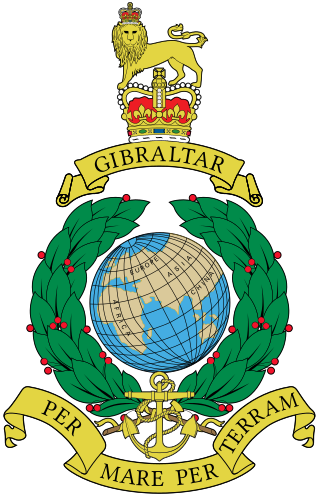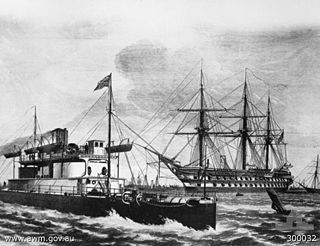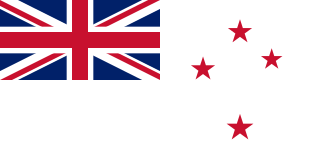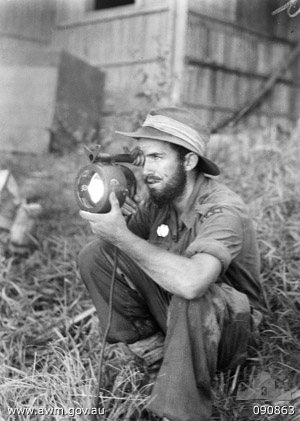This article needs additional citations for verification .(April 2014) |

A naval brigade is a body of sailors serving in a ground combat role to augment land forces.
This article needs additional citations for verification .(April 2014) |

A naval brigade is a body of sailors serving in a ground combat role to augment land forces.
Prior to the Federation of Australia, several of the Australian colonies had their own Naval Brigades with New South Wales also having a separate Naval Artillery Volunteers who manned coast artillery. [1] These units took part in the suppression of the Boxer Rebellion in China.
During the German Revolution of 1918–19, mutineering sailors of the Imperial German Navy formed the Volksmarinedivision , the best-trained and organised force available to the revolutionary socialists. They defeated regular army troops and battled the right-wing Freikorps over the direction of postwar Germany.

During the October Revolution and Russian Civil War, Bolshevik sailors were involved in storming the Winter Palace. When the Nazis invaded Russia, sailors were diverted from the battleships to aid in the defence of Leningrad and Sevastopol. Throughout the war, Russian naval infantry distinguished themselves in land combat, and eventually earned special forces status.
Within the Royal Navy, a naval brigade is a large temporary detachment of Royal Marines and of seamen from the Royal Navy formed to undertake operations on shore, particularly during the mid- to late-19th century. Seamen were specifically trained in land-based warfare at the gunnery school at HMS Excellent in Portsmouth.
The Royal Navy fought only one ship-to-ship action (HMS Shah and Amethyst against the Peruvian ship Huascar in 1877) between 1850 and 1914, so, for much of that period, its only active service was on shore, through naval brigades formed from the men aboard its vessels. Naval brigades were used in engagements including:

The field gun competition commemorates the participation of a naval brigade in the relief of Ladysmith during the Boer War, when 12-pounder guns from HMS Terrible and Powerful were dragged across almost 200 mi (320 km) of rough terrain from Durban in October 1899.
A Royal Naval Division—later designated the 63rd (Royal Naval) Division—was formed in the First World War to make use of surplus reserves of the Royal Navy who were not required at sea. It included two naval brigades and a brigade of Royal Marines, and fought in the defence of Antwerp in 1914, the Battle of Gallipoli in 1915, and the Battle of the Somme in 1916. Few naval personnel remained in the Division by July 1916, and it was redesignated as the 63rd Division. The division was demobilised in April 1919.
During the siege of Veracruz of 1847 in the Mexican–American War, a naval contingent of 1200 men joined the landing force.
During the American Civil War, both sides employed naval brigades at the siege of Petersburg. The Confederate naval brigade was commanded by Captain John R. Tucker. It was attached to George Washington Custis Lee's Division, under Lieutenant General Richard Ewell's Richmond Defense Forces. During the retreat to Appomattox, the brigade was captured at the Battle of Sayler's Creek on 6 April 1865. s. The Union naval brigade was under the Army of the James under Major General Benjamin Butler. It was commanded by Brigadier General Charles K. Graham and was not assigned to either of the two corps of the army.
During the war on terror in Iraq and Afghanistan, individual augmentees from the United States Navy served in the Army to make up for a shortfall of army personnel.

The Corps of Royal Marines (RM), also known as the Royal Marines Commandos, are the UK's special operations capable commando force, amphibious light infantry and also one of the five fighting arms of the Royal Navy. The Corps of Royal Marines can trace their origins back to the formation of the "Duke of York and Albany's maritime regiment of Foot" on 28 October 1664, and can trace their commando origins to the formation of the 3rd Special Service Brigade, now known as 3 Commando Brigade on 14 February 1942, during the Second World War.

The Royal Naval Reserve (RNR) is one of the two volunteer reserve forces of the Royal Navy in the United Kingdom. Together with the Royal Marines Reserve, they form the Maritime Reserve. The present RNR was formed by merging the original Royal Naval Reserve, created in 1859, and the Royal Naval Volunteer Reserve (RNVR), created in 1903. The Royal Naval Reserve has seen action in World War I, World War II, the Iraq War, and War in Afghanistan.

Amphibious warfare is a type of offensive military operation that today uses naval ships to project ground and air power onto a hostile or potentially hostile shore at a designated landing beach. Through history the operations were conducted using ship's boats as the primary method of delivering troops to shore. Since the Gallipoli Campaign, specialised watercraft were increasingly designed for landing troops, material and vehicles, including by landing craft and for insertion of commandos, by fast patrol boats, zodiacs and from mini-submersibles.

The Eight-Nation Alliance was a multinational military coalition that invaded northern China in 1900 with the stated aim of relieving the foreign legations in Beijing, then besieged by the popular Boxer militia, who were determined to remove foreign imperialism in China. The Allied forces consisted of about 45,000 troops from the eight nations of Germany, Japan, Russia, Britain, France, the United States, Italy, and Austria-Hungary. Neither the Chinese nor the quasi-concerted foreign allies issued a formal declaration of war.

The Fusiliers marins are specialized French naval infantry trained for combat on land and coastal regions. The Fusiliers marins are also in charge of providing protection for naval vessels and key French Navy sites on land.

Marines, or naval infantry, are typically a military force trained to operate in littoral zones in support of naval operations. Historically, tasks undertaken by marines have included helping maintain discipline and order aboard the ship, the boarding of vessels during combat or capture of prize ships, and providing manpower for raiding ashore in support of the naval objectives. In most countries, the marines are an integral part of that state's navy.
The history of the Australian Army is the culmination of the Australian Army's predecessors and its 120-year modern history. The Army has its origins in the British Army and colonial military forces of the Australian colonies that were formed prior to the Federation of Australia. These were gradually united into federal units between 1899 and 1903; thus forming the beginning of the Australian Army. The colonial forces were combined and formed the basis of the new army, when the Commonwealth of Australia was founded on 1 January 1901. The modern history of the Army began with its founding at the start of the 20th century as the colonial armies were officially united as the Commonwealth Military Forces. In 1916 the title 'Australian Military Forces' was adopted and remained its official name until 1980, after which it became known as the Australian Army.

Before Federation in 1901 five of the six separate colonies maintained their own naval forces for defence. The colonial navies were supported by the ships of the Royal Navy's Australian Station which was established in 1859. The separate colonies maintained control over their respective navies until 1 March 1901, when the Commonwealth Naval Forces was created.

The history of the Royal New Zealand Navy leads back to early New Zealand-based gunboats used in controlling the British interests in the new colony, as well as to the strong linkages to the British Navy itself.

The history of the United States Marine Corps (USMC) begins with the founding of the Continental Marines on 10 November 1775 to conduct ship-to-ship fighting, provide shipboard security and discipline enforcement, and assist in landing forces. Its mission evolved with changing military doctrine and foreign policy of the United States. Owing to the availability of Marine forces at sea, the United States Marine Corps has served in nearly every conflict in United States history. It attained prominence when its theories and practice of amphibious warfare proved prescient, and ultimately formed a cornerstone of U.S. strategy in the Pacific Theater of World War II. By the early 20th century, the Marine Corps would become one of the dominant theorists and practitioners of amphibious warfare. Its ability to rapidly respond on short notice to expeditionary crises has made and continues to make it an important tool for U.S. foreign policy.

Historically, Scotland has a long military tradition that predates the Act of Union with England. Its soldiers form part of the armed forces of the United Kingdom, more usually referred to domestically within Britain as the British Armed Forces.

The Portuguese Marine Corps constitutes the Elite Commando Raid Force and Special Operations branch of the Portuguese Navy. It has roles similar to the ones of the USMC Reconnaissance Battalions and of the Royal Marine Commandos. The Corps is specialised in amphibious warfare, coastal reconnaissance, unconventional warfare, guerrilla warfare, raids, maritime interdiction and boarding operations. It is an elite light infantry force, operating as a rapid-reaction force. Today’s Corpo de Fuzileiros is the premier raid force. The fuzileiros remains an all-volunteer force with an intensive screening and selection process followed by combat-focused training. Fuzileiros are resourced to maintain exceptional proficiency, experience and readiness.

The Battle of the Taku or Dagu Forts was a short engagement during the Boxer Rebellion between the Chinese Qing dynasty military and forces belonging to Eight Nation Alliance in June 1900. European and Japanese naval forces captured the Taku forts after a brief but bloody battle with units of the Qing dynasty. Their loss prompted the Qing government to side with the Boxers while the Chinese army was ordered to resist all foreign military forces within Chinese territory. Allied powers remained in control of the forts until the end of the Boxer Rebellion in September 1901.

During World War II the Royal Australian Navy (RAN) formed beach commando units to go ashore with the first wave of amphibious assaults. They would conduct local reconnaissance, signpost the beaches, control boat traffic, and communicate with the maritime forces. These were known as Royal Australian Navy Beach Commandos. They took part in the Borneo campaign.
Able seaman is a military rank used in naval forces.

Provincial Marine was a coastal protection service in charge of the waters in the Great Lakes, the St. Lawrence River and parts of Lake Champlain under British control. While ships of the Provincial Marine were designated HMS, they were operated in more of a coast guard manner than as a full-fledged navy. Operations were maintained and staffed by the Royal Navy. Most ships of the Provincial Marine were built on the Great Lakes.
The history of the Royal Marines began on 28 October 1664 with the formation of the Duke of York and Albany's Maritime Regiment of Foot soon becoming known as the Admiral's Regiment. During the War of the Spanish Succession the most historic achievement of the Marines was the capture of the mole during the assault on Gibraltar in 1704. On 5 April 1755, His Majesty's Marine Forces, fifty Companies in three Divisions, headquartered at Portsmouth, Chatham and Plymouth, were formed by Order of Council under Admiralty control.
Seebataillon, literally "sea battalion", is a German term for certain troops of naval infantry or marines. It was used by the Prussian Navy, the North German Federal Navy, the Imperial German Navy, the Austro-Hungarian Navy, the Kriegsmarine, and briefly in the Bundesmarine. In 2014, also the modern German Navy established a naval force protection unit called Seebataillon.

The historical battles of Lexington and Concord in Massachusetts sparked the beginning of the American War for Independence on 19 April 1775; soon after, the rest of the thirteen American colonies were pulled into the conflict. Many of the leaders in the rebellion recognized that a naval engagement against the British was the primary option to prevent the British from restoring Crown rule by military occupation.

The 1st Royal Naval Brigade was an infantry brigade of the Royal Navy which was formed from excess naval reserve personnel. The brigade was formed in August 1914 and assigned to the 63rd Division after that division's formation in September 1914 and served on the Western Front and during the Gallipoli campaign, until July 1916 when it was broken up. The brigade was formed once more for a few days, but once again disbanded following the division's absorption into the Army's order of battle.